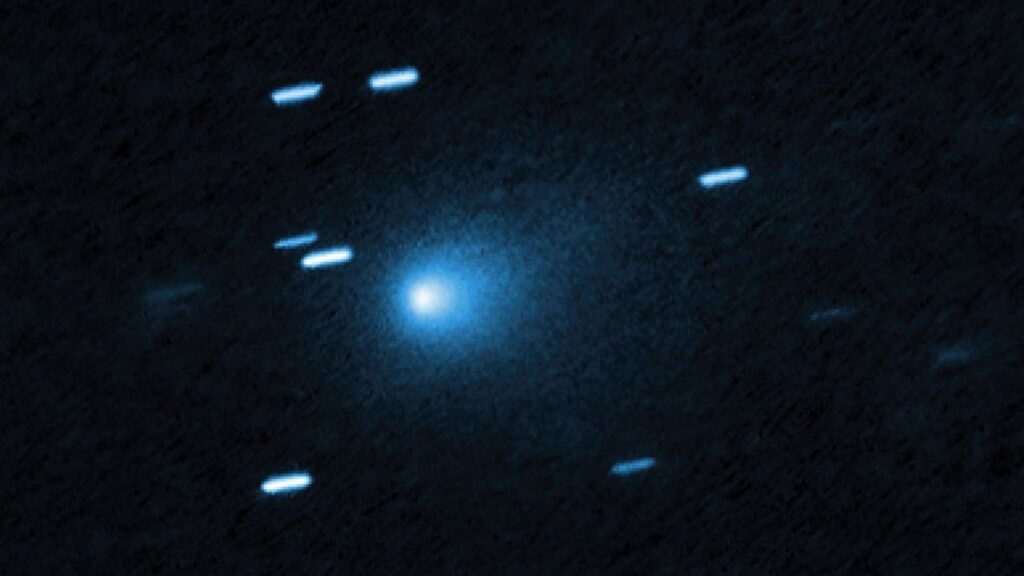
The Hubble Space Telescope has provided an unprecedented view of the interstellar comet 3I/ATLAS, revealing its distinct features and confirming its identity as a comet. Captured images illustrate a coma composed of dust particles and early signs of a tail. Discovered on July 1, 2025, by the Asteroid Terrestrial-impact Last Alert System (ATLAS), 3I/ATLAS is notable for its remarkable speed of 130,000 mph (approximately 209,000 kph), making it the fastest comet ever recorded as it traverses through the solar system.
3I/ATLAS originates from interstellar space, where it has traveled for millions of years, gaining speed from gravitational interactions with stars. As it approaches the sun, it will receive another gravitational boost, propelling it back into the depths of interstellar space, likely never to return. According to David Jewitt, a scientist at the University of California, Los Angeles, “No one knows where the comet came from… It’s like glimpsing a rifle bullet for a thousandth of a second.”
Astronomers are eager to study 3I/ATLAS, which may provide insights into the material composition of comets from other star systems. Comets typically consist of a solid nucleus surrounded by a coma, which forms when they near the sun, producing two tails: a dust tail and an ion tail. The Hubble observations indicate that 3I/ATLAS has a nucleus obscured by a coma, with estimates suggesting its size could range from 1,000 feet (approximately 320 meters) to as large as 3.5 miles (about 5.6 kilometers).
Hubble also captured a dust plume from the comet’s sunlit side, contributing to the coma and hinting at the formation of a dust tail. These characteristics are typical of comets within the solar system, although the high velocity and hyperbolic trajectory of 3I/ATLAS distinguish it as an interstellar visitor.
Despite its remarkable speed, 3I/ATLAS poses no threat to Earth. The comet will pass at a distance of 1.8 astronomical units (approximately 167 million miles or 270 million kilometers) from our planet. When it reaches its closest approach to the sun, known as perihelion, on October 29, 2025, it will be positioned further out than Mars. Even after becoming obscured by the sun’s glare, the comet will remain visible from Mars, where ongoing observations will continue from spacecraft stationed on the Red Planet. 3I/ATLAS is expected to reemerge in Earth’s skies in December 2025.
As 3I/ATLAS approaches the sun, astronomers anticipate monitoring an increase in its activity. The outgassing caused by warming will allow for spectroscopic analysis, potentially revealing more about its composition. This could be compared with native comets, as seen with 2I/Borisov, which exhibited a higher concentration of carbon monoxide than typical solar system comets. 3I/ATLAS is the third interstellar object identified, following 1I/’Oumuamua in 2017 and 2I/Borisov in 2019. Estimates suggest that thousands of similar bodies may be traversing the solar system at any moment.
The challenge in determining the population of interstellar objects stems from the inability to precisely measure the nucleus of 3I/ATLAS. If the comet is indeed one of the larger interstellar bodies, it may necessitate a reevaluation of current estimates regarding the prevalence of objects of its size. Its detection by ATLAS was due to the brightness of the coma rather than the nucleus itself, complicating predictions about the number of similar objects.
With the Vera C. Rubin Observatory in Chile nearing full operation, astronomers are optimistic about discovering more interstellar visitors in the future, potentially even before they exhibit cometary characteristics. Jewitt noted, “This latest interstellar tourist is one of a previously undetected population of objects bursting onto the scene.”
The findings concerning 3I/ATLAS have been accepted for publication in the Astrophysical Journal Letters, with a pre-print of the study currently available. The research represents a significant advancement in our understanding of interstellar objects and their role in the broader context of our solar system.





